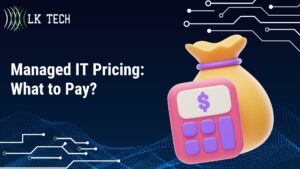Unpacking Managed IT Services Pricing: What Should You Expect to Pay?
For modern businesses, having robust IT support in place is no longer optional. Relying on outdated systems or trying to manage complex IT infrastructure without an expert team leads to frustrating downtime, costly breaches, and lost productivity. This is why more companies are turning to managed IT services.
With managed IT services, an experienced provider handles all your technology needs for a predictable monthly fee. But when it comes to evaluating providers and service plans, the specific pricing and cost structures can seem unclear. This article will fully break down the key factors that influence managed IT pricing. With a better understanding of the models, variables, and value considerations involved, you can determine reasonable pricing expectations for your organization.

- Managed IT Pricing: What to Pay?
Popular Pricing Models Used by Managed Service Providers (MSPs)
Most MSPs use one of these basic pricing models:
Per-User Pricing
With per-user pricing, costs are calculated based on the number of users in your organization. This model is common because it scales easily as your business grows or shrinks. Per user fees are often based on:
- The number of active email addresses in your domain
- The number of user accounts in your network domain controller or Active Directory
- The total number of employees, regardless of whether they use devices
Per-user pricing ranges from $30-$300 per user per month, with more typical rates falling between $80-$150 per user. This model works well for companies where the number of employees is a rough reflection of IT support needs. It allows predictable budgeting.
However, one downside is that per-user pricing does not account for variations in the number of devices used. Large device networks require more management overhead.
Per-Device Pricing
With per-device pricing, monthly costs are calculated based on the total number of devices connected to your network. This allows costs to scale based on your actual IT infrastructure size.
Devices counted typically include:
- Laptops, desktops, and tablets
- Servers
- Networking equipment like switches and routers
- Printers, scanners, and copiers
- VOIP phone systems
- Custom hardware like point-of-sale systems
Per-device pricing may range from $100 - $300 per device monthly. This model works well when your device network is proportionally larger than your number of users. It avoids paying for unused capacity.
However, per-device pricing can undercharge for user support time if you have many employees relative to devices. It also provides less predictable scaling compared to per-user models.
Hybrid Per-User and Per-Device Models
Some MSPs use a hybrid pricing model that accounts for both the number of users and number of devices in an organization.
This allows costs to scale appropriately as either users or devices grow. It aims to provide the best of both models.
Hybrid models may have a base per-user fee, with additional per-device charges stacked on top. For example, a company may pay:
- $100 per user
- Plus $150 per device
This balances user support costs with infrastructure management costs. However, it involves more pricing variables to calculate.
Be sure to communicate details about your organization's user and device counts so potential MSPs can recommend the best pricing model for you.
Factors That Influence Managed IT Pricing
In addition to the pricing model, the specific services included in your contract have a significant impact on overall monthly costs. As you evaluate providers, consider these variables:
Service Offerings and Tiers
Most MSPs offer tiered plans with different service levels at different price points. Entry-level tiers often focus on core offerings like:
- 24/7 monitoring and alert response
- Patch management
- Remote help desk support
Higher tiers add services like:
- Advanced security features (firewalls, endpoint detection)
- Business continuity and backup
- Virtual CIO strategic guidance
- Onsite support hours
Clearly understanding the services included in each tier allows you to select the right level for your needs and budget. Be wary of providers who don't share detailed service checklists and tier breakdowns.
Additional Projects and Services
Your monthly managed services fee covers your provider's core responsibilities and deliverables outlined in the SLA. But additional hourly or one-time charges may apply when you request new projects like:
- New software implementations
- Infrastructure upgrades
- Office moves that require IT changes
- Custom application development
Reputable providers are transparent about these additional fees so you can budget appropriately. Some may offer bundled packages or discounts for common add-ons.
Support Hours and Response Times
Look closely at support hours and guaranteed response times. 24/7 monitoring with fast response typically costs more than more limited "business hours" support.
Service Level Agreement Terms
Review SLAs carefully to understand specific deliverables. Vague or lax SLA terms may indicate managed IT "in name only" rather than expert, proactive services.
Geographic Service Area
Does your provider have local in-house support staff? Nearby teams allow faster onsite response when needed. Companies relying solely on remote support generally have lower pricing but may lack responsiveness.
Key Value Considerations Beyond Just Cost
The specific monthly rate your organization pays depends on all the factors outlined above. But the quality and expertise of the provider matters much more than bargain-basement pricing. Consider:
Specialized Industry Experience
Look for MSPs with proven success supporting organizations in your specific industry. This vertical expertise allows them to customize technology for your needs and comply with industry regulations.
Technical Certifications
Certifications like Microsoft Partner, Cisco, and CompTIA indicate technical competence. Certified experts reduce downtime risks and handle complex projects more smoothly.
Tenure and Reputation
How long has the provider been in business? Do they have many long-term clients? An MSP's track record proves their reliability.
Client References
When comparing providers, request client references to understand real customer experiences. Steer clear of those hesitant to provide references.
Staffing and Bandwidth
Understaffed MSPs juggle many clients per technician, leading to delays or lack of individual attention. Ask about staff size, tenure, and workload.
Proactive vs Reactive Focus
Proactive MSPs emphasize robust monitoring, maintenance, and IT strategy planning to prevent issues before they occur. Reactive break-fix mentalities result in outages and inefficiencies.
Breadth of Services
MSPs offering diverse services with many areas of expertise provide greater convenience and value.
Cybersecurity Capabilities
Given rising cyber threats, prioritize MSPs with modern security tools and practices. Avoid providers lacking emphasis on security.
By partnering with a more qualified MSP, you gain access to superior expertise and service delivery. This prevents problems, optimizes efficiency, and provides long-term technology guidance to help your business grow. The resulting productivity gains and risk reduction offset higher base rates.

- Managed IT Pricing What to Pay?
Typical Managed IT Pricing Ranges
While specific monthly costs depend on the variables above, managed IT services typically range from:
- Small Business Tier - $1000 - $5000 per month
- For companies with up to 50 employees
- Covers essential monitoring, help desk, backups, etc.
- Mid-Market Tier - $5000 - $15,000 per month
- For companies with 50-200 employees
- Adds more advanced features and support hours
- Enterprise Tier - $15,000+ per month
- For large corporations with extensive infrastructure
- Premium services and dedicated account management
Most small and mid-sized businesses can expect to invest $100 - $250 per user monthly for a robust managed solution. Defining your must-have features and comparing tiered pricing allows you to find the ideal balance of service levels and affordability.
Get Managed IT Pricing Tailored to Your Business
While the costs involved for managed IT require careful evaluation, the benefits for your organization make it a smart investment. Partnering with the right provider gives you complete IT support, reduced downtime, more flexibility to grow, and better security.
LK Technologies offers managed IT services tailored to Cincinnati, Ohio area businesses across industries. To get pricing customized for your specific needs, schedule a consultation today. Their team of certified experts will provide recommendations to maximize technology value and productivity with your budget.


